When it comes to attractions, Indonesia is as varied as its 17,000 islands, and visitors will be swamped with an endless list of things to see and do. There are cultural, historical, religious and natural attractions aplenty, and as such it may be wise to select one or two islands to explore in order to avoid suffering from a sightseeing overload.A popular place to tackle first is Java, a touristic favourite not least because of the incredible volcanic scenery in its Bromo-Tengger-Semeru National Park. The island is also home to the grungy metropolis of Jakarta and the historic Yogyakarta. On Java, travellers can find anything from glitzy nightclubs to ancient ruins to traditional puppet theatre. If the laid-back aesthetic of "Eat Pray Love" is what you are after, head straight to Bali. This hugely popular island has been luring in visitors for years thanks to its white sandy beaches, endless surfing spots and inland cultural attractions.For a wider range of natural attractions, one can get lost on the mammoth island of Sumatra, which offers visitors traditional towns, such as Bukit Lawang and Bukittinggi, and stunning landscapes. Bigger yet is Borneo, which shares its jungle treks with visitors and native orangutans alike and is a delight to explore.A lumbering ferry line connects all the main islands and attractions and is an adventure itself. The best time is visit is between May and September, during the dry season, which also makes transport easier.
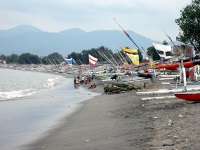
Ampenan-Mataram-Cakranegara-Sweta, or more simply referred to as Ampenan, is a vibrant district located on Indonesia's lush Lombok Island. The sprawling metropolis is comprised of four towns, the boundaries of which are indistinguishable to the casual visitor, and is host to a population of around 250,000 people. While Sweta is the main transport hub and site of the island's biggest market, it is bustling Ampenan, the old port town furthest west, that is the main tourist area and the location of most shops, hotels and restaurants.Most visitors pass through the area fairly quickly but there are one or two sights worth seeing nearby, including the weaving factories in the capital Mataram, whose processes have remained largely unchanged for hundreds of years, and a weaving village to the south where traditionally dressed women work on wooden handlooms. There are a number of shrines and temples open to visitors, the best of which are centred around the Mayura Water Palace, dating from 1744 and used by the royal court during the Balinese rule of Lombok.Ampenan, being an old port town, has a beach still lined with hundreds of fishing canoes. As the fishermen mostly go out at night, it is fun to watch the boats setting off in the late afternoon, and seeing the sun set over the water. Ampenan's market, which is the areas primary attraction, is located along the main road to Senggigi, north of the city proper. The Pura Segara Balinese temple is close by on the beach.
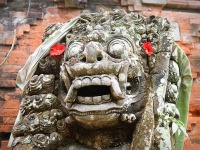
The small village of Batubulan is marked by stone figures of gods and demons on the side of the road. Known mostly for its stone carvings, Batubulan is a popular centre for cultural tourism and attracts travellers looking for a unique souvenir to take home with them. Visitors to the village can even enjoy visiting the workshops and watching the artists at work. Batubulan actually means 'moonstone' and stone carving has been the main industry of the village for a long time. Everybody seems to be an expert in the art and children learn how to coax statues out of rock at a young age. The village does also showcase other crafts, like woodwork and textiles, and is known for its antiques but the stone work dominates.The temples in the area reflect the traditional talent of the local inhabitants and some remarkable stone carvings are on display at temples such as Pura Puseh. Another of the village's specialities is the performance of the blessing dance of Barong, which is performed on a daily basis at five different locations or stages: the Puseh Temple, Tegal Tamu, Denjalan, Sahadewa and Sila Budaya. As the village has become such an artistic hub, other villages nearby have perfected their own crafts, and the whole region is slowly transforming in to a vast open-air market.
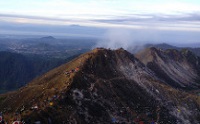
A great place to stop off for travellers en route to the holiday resort of Lake Toba, the town of Berestagi is famed not only for its passion fruit, but also for the two active volcanoes on its doorstep: Gunung Sibayak and Gunung Sinabung. Gunung Sibayak boasts fantastic hot springs whose warm waters are not only open to the public, but are also believed to have therapeutic properties.More active travellers can climb this mountain instead, earning breathtaking views over the island of Sumatra from the top. This is the most commonly climbed volcano in Sumatra as the hike to the top is comparatively easy, with beautiful and unusual scenery to enjoy along the way. It only takes about two hours to summit and can be done safely without a guide. However the addition of a local expert who can explain the geological significance of the area, as well as identify the local flora and fauna, is worth considering. The volcano is still active and as such the boiling sulphur imbues the region with an unmistakable stench, but the breathtaking views will quickly distract you from this unpleasant factor. Why not reward yourself and head to the hot springs after the hike? The pools range in temperature from pleasantly warm to boiling hot, so be sure you test the water and don't burn yourself!
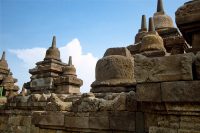
One of the greatest Buddhist monuments in South East Asia, Borobudur was built in the 8th century and stands on top of a hill surrounded by volcanoes and overlooking green fields. It is an immense, multi-tiered structure with the Great Stupa (bell-shaped monument) at the top standing 128ft (40m) above the ground, surrounded by numerous smaller stupas, some still containing Buddha statues inside. It is part of a 2.5 mile-long (4km) chain of smaller temples, with the Mendut Temple containing three exquisitely carved giant statues of Buddha and two disciples inside. The terraces of Borobudur are covered in sculpted reliefs, with narrative panels illustrating Buddhist beliefs and teachings, and covering an estimated length of 3.5 miles (6km). These masterpieces of individual artistic value have been acknowledged as the most complete and splendid collection of Buddhist reliefs in the world. Built out of millions of blocks of the local volcanic rock joined without the use of mortar, Borobudur is listed as a UNESCO World Heritage Site and is the primary tourist attraction in Java, as well as one of the most iconic sites in Indonesia.The temple lies 25 miles (41km) northwest of Yogyakarta. Unsurprisingly for such a famous attraction, Borobudur can get very crowded, which diminishes the impact of the place for some - try to get there for sunrise to avoid the throng and for the magical experience of seeing the day begin at the temple.
Address : Borobudur, Magelang, Central Java
Website : www.borobudurpark.com/the-borobudur-temple/
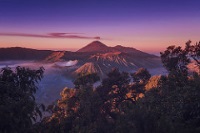
The Bromo-Tengger-Semeru National Park encloses spectacular volcanic landscapes and one of the most impressive natural sights in Indonesia. The ancient Tengger crater in its midst stretches for six miles (10km) and within its sheer volcanic walls are three peaks; Batok, Kursi and the smoking Mt Bromo. Thousands of tourists make the journey up Mt Bromo for the unforgettable spectacle at sunrise (during the dry season) when the surrounding landscape takes on an otherworldly quality. The views from the top and into the smoking crater are unbelievable. To reach the foot of the volcano one must cross the vast Sea of Sand out of which Mt Bromo rises, either on horseback or by foot, and then climb a flight of stairs that leads to the crater rim where the unmistakable smell of sulphur permeates the air. Mount Semeru, another volcano in the park, is one of Indonesia's most active volcanoes and every 20 minutes or so it belches out smoke, to the delight of visitors. The small village of Cemora Lawang, perched at the edge of the Tengger crater, is the most popular place to stay and has the best views of the area. With unique landscapes that look like something out of a fantasy novel, this National Park is an exciting area to explore and a dream come true for photographers.The nearest big city to the park is Yogyakarta, and although it takes more than 10 hours to drive to the volcanoes, it is a popular excursion and is included in many tour packages.
Address : Park office: Jl.R.Intan No 6, Malang, East Java
Website : www.bromotenggersemeru.org/
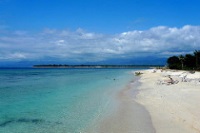
Situated a few miles off the northwest coast of Lombok, the three Gili Islands - Gili Trawangan, Gili Meno and Gili Air - were 'discovered' by backpackers in the 80s and until recently remained a laid-back haven for budget travellers in search of a peaceful and secluded holiday paradise. The islands are surrounded by glorious soft sandy beaches, colourful coral reefs and crystal clear turquoise waters, ideal for diving.There are almost no roads or motor vehicles on the islands, with scooters and donkey-drawn carts acting as their replacements. Small ferries transport guests between the Gili Islands, none of which are more than twenty minutes apart. Most of the holiday accommodation is on Gili Trawangan, and this generally consists of small bamboo bungalows a few metres from the beach, like those found on Thailand's islands twenty years ago.Mainstream tourism is beginning to establish itself on the Gili Islands and a few exclusive hotels have opened up, most recently on the smallest, least developed island of Gili Meno. While there are no major sights or landmarks to see, the scuba diving and snorkelling opportunities are enough to make it a popular destination and the atmosphere and scenery are splendid enough to enchant visitors.
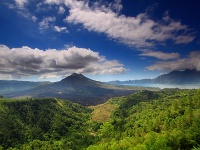
The still-active Gunung Batur volcano is known as Bali's second holiest mountain and symbolises the female element of the island. The male element is symbolized in Gunung Agung, a neighbouring smaller volcano. The walk up Mount Batur is not easy, but the views are spectacular and if you're lucky you might even spot a few monkeys along the way. Gunung Batur rises from a volcanic crater which also contains a lake and the view of this otherworldly landscape from the crater rim is spectacular. Look out for the remanants of black lava flows on the western side of the mountain from this vantage. There is also a great lookout point for those who'd rather hire a car and drive to the old crater rim overlooking Lake Batur.The sunrise walks are recommended, and remain the best way to avoid hiking during Bali's infamous year-round heat. Unfortunately, those visiting during the rainy season may be unlucky with the views as visibility is often poor. There is a guide hut situated at the bottom of the path and passing by usually attracts a mob of eager locals who insist on your taking one of them along for safety. If you want a guide, then this arrangement is convenient, however the hut can be avoided by taking alternative paths. It is safe to ascend on your own, but caution is always advised for less experienced hikers.
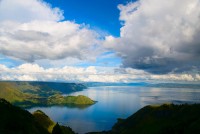
The holiday paradise of Lake Toba, sparkling like a precious stone, is embedded in the northern highlands of Sumatra and is surrounded by steep and fertile mountains. Filling in a giant volcanic crater, it is the largest lake in South East Asia, with depths of up to 1,680 feet (525m) in places. In the middle of Lake Toba sits the jade-green island of Samosir, which is thought to be the origin of the friendly Batak people. Evidence of their culture and traditions is visible in the little Batak villages with their characteristic curved roofs, the traditional dance performances at Simanindo's Batak Cultural Centre, and the distinctive woodcarvings and weavings sold around the island. Apart from this cultural wealth, there are also several hot springs near Pangururan, which attract visitors.Numerous holiday resorts and villages are scattered around Lake Toba's Samosir; the Tuk Tuk peninsula and village of Ambarita being the most popular places for tourists to linger. The area was once very fashionable for holidaymakers, but is now fairly quiet. Despite the amount of guesthouses and restaurants on Samosir, there is little other tourist infrastructure, but the variety of activities and the cultural experience makes this one of Sumatra's most fascinating and relaxing holiday destinations.
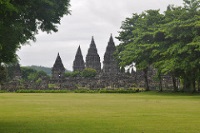
Rivalling the Buddhist monument of Borobudur, this magnificent Hindu temple is the largest in Java and arguably the most beautiful in Indonesia. Prambanan was built in the 9th century, possibly to compete with the splendour of Borobudur, or to celebrate the return to power of the Hindu dynasty in Java at the time. The complex is dominated by three main temples, Shiva, Brahma and Vishnu, each dedicated to their namesake, and the walls are decorated with exceptional relief carvings depicting scenes from the famous Hindu classic tale of Ramayana.The Shiva Temple is the largest of the three, soaring above the others at a height of 154 feet (47m), and contains the impressive statues of Shiva, his elephant-headed son, Ganesh, and the goddess, Durga. From May to October the Ramayana Ballet, a traditional Indonesian dance based on the Ramayana story, is performed on an open-air stage in the complex during the full moon - it is a spectacular sight involving hundreds of dancers, singers and musicians. Prambanan is a UNESCO World Heritage Site and never ceases to amaze visitors; there is nowhere else in the world quite like it. It is a good idea to walk a little away from the temples to get a view of the whole complex, and to walk around the outside is also interesting. Avoid the heat and crowds of midday by going early in the morning or late in the afternoon.
Address : Bokoharjo, Prambanan, Sleman Regency, Special Region of Yogyakarta
Website : www.borobudurpark.com/our-sites/prambanan/history/
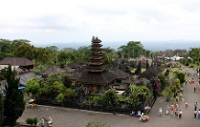
Locally known as the Mother Temple of Bali, Pura Besakih is located on the slopes of Mount Agung and is the biggest and holiest of all Balinese temples. Dating back to the 14th century, the three main temples are dedicated to Shiva, Brahma and Wisnu, and another 18 separate sanctuaries belonging to different regencies and caste groups surround these. The complex has been built over centuries and is very impressive.However, the magnificence of the experience can be somewhat blighted by the insistent local touts at the site. Apart from paying the official entrance fee, visitors are coerced into paying 'donations' to the temple and are forced into hiring tour guides. For this reason you may be advised to skip Pura Besakih in favour of some of the less famous and less crowded temples. Being aware of some of the common tourist scams, however, does makes the visit easier: it is possible to explore without a guide but you will be endlessly bothered, so it may be preferable to be with a local. If you do visit Pura Besakih, or any other temple for that matter, it is customary to wear a sarong out of respect for local traditions. Despite the hassle of dealing with touts, this is a beautiful and interesting attraction and many will find it rewarding regardless.
Address : Desa Besakih, Kec. Rendang, Karangasem, Besakih, Karangasem, Kabupaten Karangasem
Website : www.bali.com/temple_Karangasem_Pura-Besakih_83.html
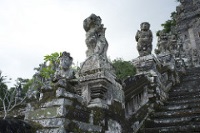
One of the most valued temples in Bali, Pura Kehen is a garden temple located in the town of Bangli in East Bali and can be traced back to the 11th century. Founded by Sri Brahma Kemuti Ketu, Pura Kehen is the second largest temple on Bali and the most sacred in the region. Many visitors are mesmerized by the temple's grandeur and the steep steps leading dramatically up to the gateway. Like the Mother Temple of Pura Besakih, Pura Kehen was built on the slope of a hill and has eight terraces. The temple complex is surrounded by palm tree plantations which adds to the visitor's impression of being a jungle explorer discovering something ancient and profound. The fire god, Brahmen, protects the temple and it is named for him - kehen means hearth or fireplace. The 38 steps lead to an ornately carved entrance and through this doorway there are three courtyards. There is a lot to see but be sure not to miss the remarkable stone lotus throne dedicated to Brahma, Shiva and Vishnu in the third, main courtyard.You will need to dress appropriately to visit the temple which means that your legs must be covered and you must have a temple-scarf (sarong) around your waist. You can rent sarongs at the temple.
Address : Desa Cempaga, Cempaga, Kec. Bangli, Kabupaten Bangli
Website : www.greenerbali.com/pura-kehen.html
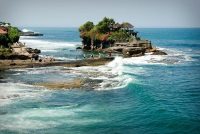
Meaning 'land in the middle of the sea', Tanah Lot is an exquisite sea temple built atop a rock formation off the island of Bali. A very popular tourist spot and a great location for photographs, Tanah Lot sits on a rocky island, in waters occupied by poisonous sea snakes which are believed to guard the temple from evil spirits and intruders. If you think its sounds like a fairytale you're not wrong; the place has a mystical quality. Despite the alleged presence of the snakes it is possible - and fun - to walk or wade to the temple cave at low tide. The temple was built by one of the last priests to arrive in Bali from Java in the 16th century and unfortunately the main temple can't be entered.Sunrise and sunset are the best times to visit, although sunset is the most popular time and the crowds can somewhat ruin the atmosphere. There are a number of vantage points from which you can get lovely views of the temple, so its best to find one of them and settle down to admire the views and take some photographs. The complex is very touristy and commercial, with lots of shops and stalls selling souvenirs, snacks and the like, but it is still a remarkable attraction to visit and the coastline is very beautiful in itself.
Address : Located at Beraban village, Kediri district, Tabanan Regency on the South Coast
Website : www.tanahlot.net/home/

Travel Guide powered by Word Travels, copyright © 2023 Globe Media Ltd. By its very nature information in this travel guide is subject to change at short notice and travellers are urged to verify information on which they're relying with the relevant authorities. Neither Globe Media Ltd nor Travel Vogue can accept any responsibility for any loss or inconvenience to any person as a result of information contained above.